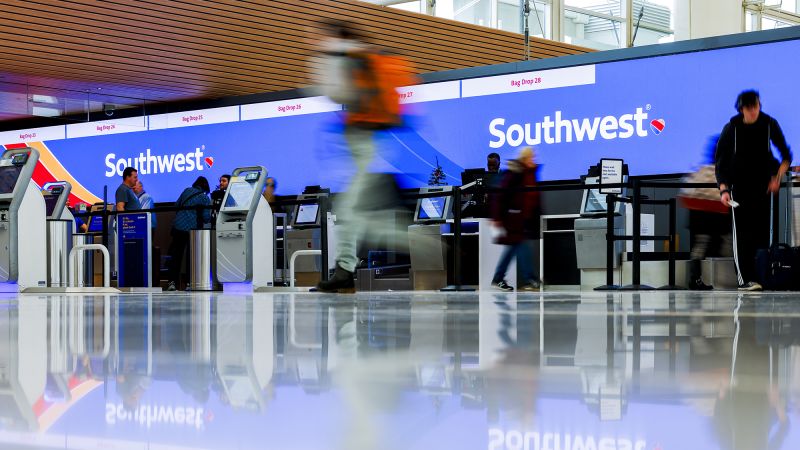Flight cancellations across the country continue to cause headaches for thousands of travelers, and Southwest is topping the list of most-affected airlines for the second consecutive day. But the source and scope of these disruptions are different from the meltdown the airline endured a year ago.
As of Monday afternoon, the airline has canceled more than 700 flights, about 18% of its schedule, setting off alarm bells that the nightmarish travel weekend could be the start of another operational fiasco for the company.
But, according to the airline, this isn’t a technology issue like the 10-day service meltdown that left more than 2 million travelers stranded during the 2022 holiday season and cost the company more than a billion dollars.
The problem is the weather. A huge swath of the country has been pummeled with harsh winter conditions this weekend, and more than 140 million people are currently under wind chill alerts stretching from the Rockies to central Texas. Over 140 daily cold records could be broken Monday and Tuesday from Oregon to Mississippi, and temperatures in Memphis, Dallas and Nashville are expected to stay below freezing for at least 72 consecutive hours.
Southwest said the delays had been pre-planned and communicated to customers in advance. The scheduling changes were carried out “to anticipate forecasted operating conditions across a wide swath of our route map – everything from wintry precipitation including blizzard conditions, to airfield and airspace constraints, and dangerous wind chill environments that require rotating ground crews to limit exposure,” a spokesperson told CNN in a statement.
Cancellations and delays should ease up considerably on Tuesday “as the storm moves East and the cold temperatures begin to moderate,” the spokesperson added. The airline pointed to a list of operational steps that it says it took in 2023 to ensure that the level of disruption that happened in 2022 does not repeat itself, including updates to crew scheduling systems and more de-icing equipment at airports.
Unlike the Southwest Airlines holiday travel meltdown of 2022, the company says the recent string of cancellations are mostly due to where Southwest flies in and out of, rather than technical issues, and that unlike the last incident, it should recover quickly.
Southwest is a major carrier at some airports that are now engulfed in an Arctic blast paralyzing much of the country. In particular, it maintains a significant presence in Chicago and Denver, which are both under wind chill advisories from the National Weather Service, and Dallas, which the NWS says could face dangerous winter conditions this week.
And Southwest isn’t the only airline that has found the icy conditions challenging. American Airlines requested a ground stop at Dallas/Fort Worth International Airport earlier Monday morning. “The ground stop from earlier was a temporary effort to alleviate the lines at the de-icing pads and free up space at the gates for inbound aircraft during our busiest arrival bank at DFW,” the airline told CNN.
The relentless winter weather caused major delays over the long holiday weekend. Saturday and Sunday saw more than 16,500 flight delays and nearly 3,000 cancellations across the United States, according to FlightAware. On Monday, the number of cancellations climbed past 2,400 while more than 5,500 flights have been postponed, making it the day with the most cancellations since the Southwest meltdown in late 2022, FlightAware data show.
These weather-related delays are exacerbating an already difficult week for airlines and their passengers. Last week, more than 200 United and Alaska Airlines flights were canceled each day due to the federally mandated grounding of Boeing 737 Max 9 aircraft. The Federal Aviation Administration instated the order after a piece of the fuselage blew off an Alaska Airlines flight on January 5 with 177 people on board. The incident left a gaping hole in the side of the plane and ripped headrests off seats as the plane flew at 16,000 feet, shortly after taking off from Portland, Oregon.
United and Alaska Airlines, the two largest US carriers using the Max 9 aircraft, are among the airlines canceling the most flights, according to the Anuvu Pulse industry dashboard. United has canceled nearly 13% of its flights, making it the second most affected airline behind Southwest, which doesn’t fly any Max 9 planes. Alaska Airlines experienced the third-highest rate of cancellations on Sunday, having called off about 15% of its total flights.
Both airlines said last week they have canceled all flights on their Max 9 planes until mid-January.
Read the full article here
